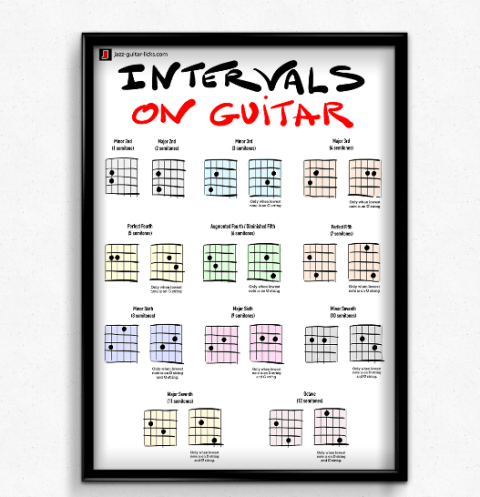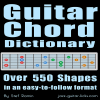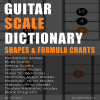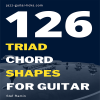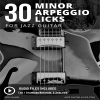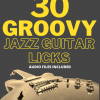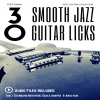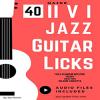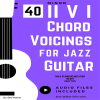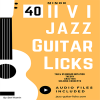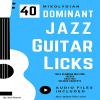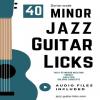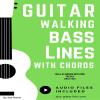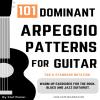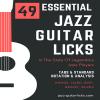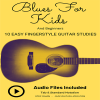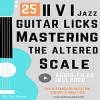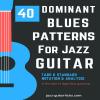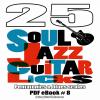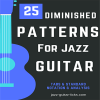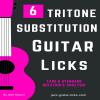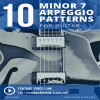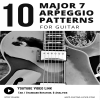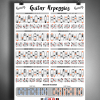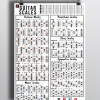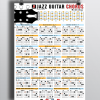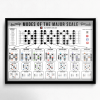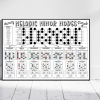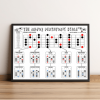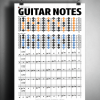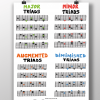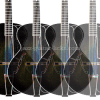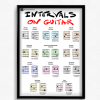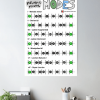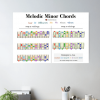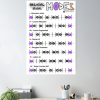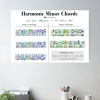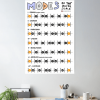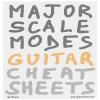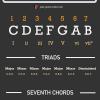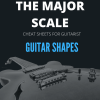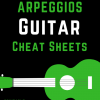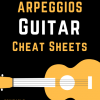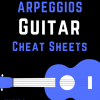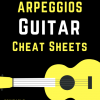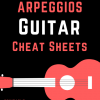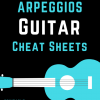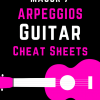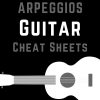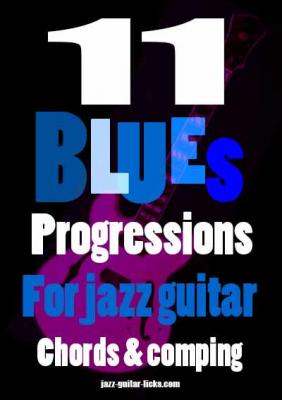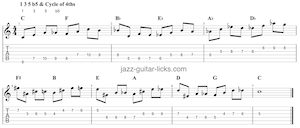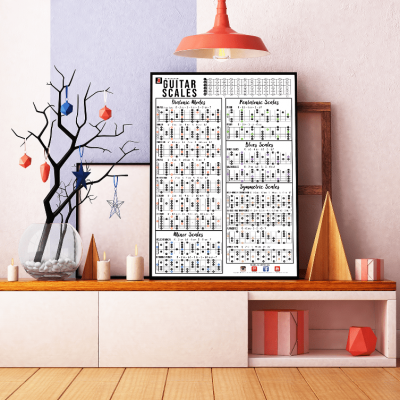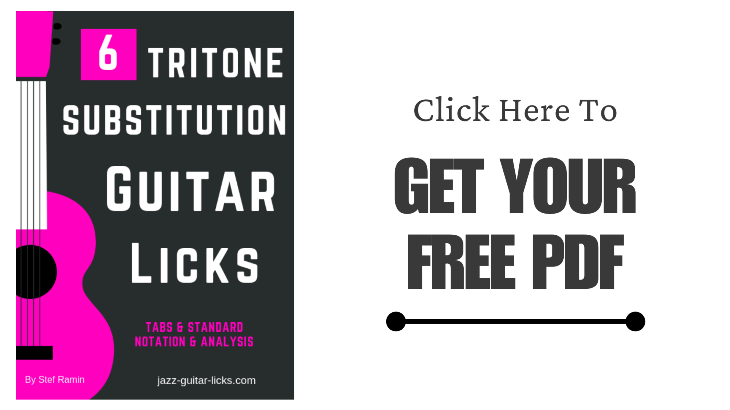
Intervals on Guitar - Shapes and Theory
- By jazz-guitar-licks
- On 2019-12-23
- In Jazz Guitar Lessons
- 0 comments
Whether simple or compound intervals are a very important part of music theory.
Knowing them allow understand how scales, arpeggios and chords are built.
Intervals are useful tools to visualize the notes and understand their relationships on the guitar fretboard.
This lesson with downloadable pdf, guitar shapes and theory will help you better figure them out and play them on guitar.
What Is An Interval in Music?
An interval is the distance between two notes, it is labelled by a number and a quality. Intervals can be harmonic and melodic. A harmonic interval is when two notes are played together whereas the notes of a melodic interval are played successively.
What is Interval Quality?
There are five qualities of intervals namely :
- Perfect (P).
- Minor (m or b).
- Major (M or sometimes represented by a triangle ∆).
- Diminished (dim. or bb).
- Augmented (aug. or #).
What is Interval Number?
An interval number represent the position of a note from the root/tonic (R/1) or any other note. These numbers are : 1 (unisson), 2 (second), 3 (third), 4, (fourth), 5 (fifth), 6 (sixth), 7 (seventh), 8 (octave).
Exemple : E is the third of C (the third note after C), G is the fifth, etc. This intervals are called "simple intervals".
It is possible to count past 8, this is what we call compound intervals, they span more than one octave :
- 9 (ninth) actually second + octave.
- 10 (tenth) third + octave.
- 11 (eleventh) fourth + octave.
- 12 (twelfth) fifth + octave.
- 13 (thirteenth) six + octave.
Exemple, A is the thirteenth of C.
List of intervals - Simple and Compounds
Simple intervals :
You see that a second can be major (2) or minor (b2).
A third can be major (3) or minor (b3).
A fourth can be perfect (P4) or augmented (#4).
A fifth can be perfect (P5), diminished (b5) and augmented (#5).
A sixth can be minor (b6) or major (6).
A seventh can be minor (b7) or major (M7).
- 1 Unisson (Root).
- b2 or m2 - minor second - 1 semitone from the root.
- 2 or M2 or ∆2 - Major second - 2 semitones from the root.
- b3 or m3 - minor third - 3 semitones from the root.
- 3 or M3 or ∆3 - Major third - 4 semitones from the root.
- 4 or P4 - Perfect fourth - 5 semitones from the root.
- #4 or aug4 - Augmented fourth - 6 semitones from the root.
- b5 - or dim5 - Diminished fifth - 6 semitones from the root.
- 5 or P5 - Perfect fifth - 7 semitones from the root.
- #5 or aug5 - Augmented fifth - 8 semitones from the root.
- b6 or m6 - minor sixth - 8 semitones from the root.
- 6 or M6 or ∆6 - Major sixth - 9 semitones from the root.
- b7 or m7 - minor seventh - 10 semitones from the root.
- 7 or M7 or ∆7 - Major seventh - 11 semitones from the root.
- 8 or 8va - Octave - 12 semitones from the root.
Compound intervals :
The most used compound intervals are the b9, 9, #9, 11, #11, b13 and 13.
They are used to enrich / extand a chord or an arpeggio.
- b9 or m9 - minor ninth = Minor second plus an octave.
- 9 or Maj9 or ∆9 - Ninth = Major second plus an octave.
- #9, 9+ or aug9 - Augmented ninth = Augmented second plus an octave.
- 10 - Tenth = Major third plus an octave.
- 11 - Eleventh = Perfect fourth plus an octave.
- #11 - aug11 - Augmented eleventh = augmented fourth plus an octave.
- 12 - Twelfth = Perfect fifth plus an octave.
- b13 or min13 - Minor thirteenth = Minor sixth plus an octave.
- 13 - Thirteenth = Major sixth plus an octave.
Intervals On Guitar
Notes on the Guitar Neck
Here are two neck diagrams that will help you locate the notes on the guitar and give a name to the intervals.
The first shape includes sharp notes whereas the second shows the flat notes.


Perfect Fourth (4 or P4)
A perfect fourths is built with two tones (2 steps) and one semitone (1 step).
It is used in quartal harmony for building chords in fourths for comping over jazz modal tunes.
The fourths are also used for practicing scales, chords and arpeggios following what we call the "cycle of fourths" (aka circle of fifths).
Augmented Fourth (#4 or aug4) / Diminished fifth (b5 or dim5) / Tritone
An augmented fourth is built with three tones, it is one more half-step than a perfect fourth.
It can also be seen as the diminished fifth.
This interval is also known as "Tritone interval" or "Devil's Interval".
It is found in dominant chords, m7b5 chords and diminished chords and obviously the basic element in tritone substitutions.
Minor Sixth (b6 or m6)
A minor sixth interval is built with eight half tones (or four whole tones) producing a melancholic sound easily recognizable in the harmonic minor scale for example.
It is rarely found in chords.
Minor Seventh (b7 or min7)
A minor seventh interval is made of 10 half tones.
This is an important interval in jazz music very used to turn basic triads into jazz chords as m7, Maj7, dom7, m7b5 and dim7.
Octave (8 or 8va)
An octave is the interval between two notes of the same name. It is made of twelve half tones.
It is an interesting part of jazz language, a technique popularized by Wes Montgomery which consists in playing simultaneoulsy two notes separated by on octave.
Augmented Eleventh (#11)
An augmented eleventh interval is an 11th interval with a supplementary semitone, in other way it's an augmented fourth + one octave.
It serves to alter (bring tension) a chord. Examples with 7#11 and maj7#11 chords.
Here are two shapes that show how look thirteenth intervals on guitar.
You can see that the 13th is a half-step above the b13.
INTERVALS ON GUITAR - PDF FILE
![]() Intervals on guitar chart (1.2 Mo)
Intervals on guitar chart (1.2 Mo)
-
Guitar Chord Dictionary
This PDF eBook provides over 550 guitar chord shapes. This is the perfect reference guide to understand how chords are built and how to play them on the guitar neck. -
Guitar Scale Dictionary
This E-book is a printable PDF method including over 700 scale diagrams and formula charts for guitarists. -
Harmonized Scales For Guitar
Complete guitar PDF on harmonized scales: major, minor, harmonic and melodic. Includes chord and arpeggio diagrams, charts and practical tabs. -
172 Arpeggio Shapes For Guitar
This printable PDF is a method dedicated to guitarists of all styles who want to learn build and play the most important types of arpeggios. -
126 Triad Chord Shapes
This handbook for guitar players is intended both for teachers and students. It includes 126 guitar shapes for mastering triads. -
Harmonic Major Scale Chords
this PDF offers diagrams and tabs for guitar to learn the chords of the harmonic major scale. -
Major Scale Harmonization
This package provides a printable PDF with exercises and audio files to learn how to harmonize the major scale with 3 note chords and their extensions. -
30 Minor Arpeggio Licks
This package includes a printable PDF method containing 30 exercises with tabs, staves and audio files for practicing minor arpeggios on guitar. -
II V I Bundle - 170 Exercises
This bundle contains 4 PDF methods for a total of 170 exercises with tabs, staves, analysis & audio files for practicing scales, arpeggios licks & chords over the 2-5-1 progression. -
Diatonic Licks Bundle
This package contains 120 jazz guitar lines based on diatonic modes as Mixolydian, Dorian and Ionian. PDF format with tabs, audio files and analysis. -
30 Groovy Jazz Guitar Licks
This downloadable package contains a PDF WITH audio files giving access to 30 groovy guitar phrases mixing jazz, blues and funky licks for beginners. -
30 Smooth Jazz Guitar Licks
In this package you'll get a printable PDF Method with tabs, notation, analysis, scale shapes and audio files for practicing 30 smooth jazz guitar licks. -
40 II V I Jazz Guitar Licks
This pdf method for guitar contains fourteen 2 5 1 jazz guitar lines with tab, standard notation, analysis, scale charts and audio files. -
50 II-V-I voicings
This printable PDF guitar method provides 50 exercises with audio files, analysis, tab and staves for learning major 2-5-1 chord voicings. -
40 Minor 2 5 1 Chord Voicings
This PDF method contains 40 exercices with tabs, scores and audio files for practicing jazz guitar chords over the minor 2 5 1 progression. -
40 Minor II V I Licks
This guitar method is a printable PDF with tabs, diagrams, theory and audio files providing 40 minor 2 5 1 jazz patterns. -
40 Mixolydian Jazz Guitar Lick
PDF guitar method with tabs, audio files and theory providing 40 dominant jazz guitar lines for teachers and students. -
40 Minor Jazz Guitar Licks
This printable guitar method in PDF format contains 40 easy minor jazz guitar lines based on the Dorian mode. -
40 Major Jazz Guitar Licks
Printable PDF eBook method containing 40 major jazz guitar licks with tab, standard notation and audio files for beginners and intermediates. -
Guitar Walking Bass Lines
This jazz guitar method about walking bass lines and chords is available as a PDF files containing 35 exercises with tabs, analysis and audio files -
101 Dominant Arpeggio Patterns
This printable PDF method provides 101 dominant arpeggio exercises with tab, theory and standard notation for the jazz, blues and rock guitarist. -
49 Essential Jazz Lines
This printable eBook method in PDF format provides 49 jazz solo transcriptions of the greatest jazz musicians. Tab, standard notation, audio files & analysis. -
11 Jazz Blues Studies
11 jazz blues chord studies with tabs, standard notation, analysis, and audio recordings and PDF. -
10 Easy Fingerstyle Blues
This PDF with Tabs and audio files provides 10 easy acoustic fingerstyle blues guitar studies for kids and beginners. -
25 Altered Jazz Guitar Lines
This PDF eBook method contains 25 altered jazz guitar licks with tabs, patterns, scale charts and audio files to master, apply and develop the altered scale. -
40 Blues Dominant Patterns
This printable method is available as a PDF file containing 40 easy dominant jazz-blues guitar lines with tabs, standard notation, analysis, audio files and scale charts. -
25 Pentatonic Licks
This jazz guitar method is an eBook available as a PDF with standard notation, guitar tabs, diagrams, analysis, audio files and backing tracks. You will find in this booklet 25 easy jazz guitar lines with theory using common and rare pentatonic scales. -
25 Soul Jazz Guitar Licks
You will find here an eBook available in PDF containing 25 soul jazz and hard bop guitar licks in the style of Grant Green, Melvin Sparks, George Benson. -
25 Diminished Patterns
This eBook PDF with audio files contains 25 dominant diminished jazz guitar patterns using the half-whole diminished scale and diminished 7th arpeggios. -
6 Tritone substitution licks
This Printable PDF eBook available for free download contains 6 easy jazz guitar licks with tabs/notation, youtube video link and analysis about the tritone substitution. -
10 Minor 7 Arpeggio Patterns
This printable PDF eBook offers 10 easy minor 7 arpeggio patterns with its related YouTube video for beginner guitarists. -
10 Easy Major 7 Arpeggio Licks
This is a printable PDF for beginner jazz guitar players providing 10 easy licks to practice major 7 arpeggios. -
10 Chord Melody Lines
Within this package, you'll discover a set of ten chord melody exercises for beginners. Printable PDFaudio files, a backing track, and a link to the associated YouTube video. -
10 Minor Blues Scale Licks
You'll find here a PDF with 10 easy jazz guitar licks to practice the minor blues scale on guitar.
-
Guitar Arpeggios Poster
This giant guitar poster for any guitar player, student or instructor contains colorful arpeggio diagrams. Giant size 24 x 36 inches (60 x 90 cm). -
Guitar Scales Poster 24*36
Guitar posters and wall art with eighteen neck diagrams representing the most used scales in music. -
Guitar Chord Poster
This printed color posters contains 63 guitar chord diagrams for jazz players, students, teachers and schools. -
Guitar Modes Poster
Guitar reference posters and wall art about modes of the major scale for guitar teachers, students and music schools. -
Melodic Minor Modes Poster
Educative and decorative giant guitar poster with neck diagrams, interval names about the seven modes of the melodic minor scale. -
Pentatonic Scale Guitar Poster
This guitar reference poster shows the positions and intervals of the major pentatonic scale. -
Guitar Notes Poster
This is a giant poster showing the notes on the guitar fret board and their positions on a musical staff. -
Triads Guitar Poster
This reference poster show the positions and intervals of the main triads used on guitar. This is a useful tool for guitarists, teacher and students. -
Four Archtop Guitars Poster
This is a decorative poster with four archtop jazz guitars. Several size and colors in landscape format available on Teespring and redbubble. -
Intervals On Guitar - Poster
This giant poster for guitar provides neck diagrams with interval positions. -
Melodic Minor Modes
This music theory poster available in several sizes shows the construction of the seven modes of the melodic minor scale. -
Major Scale Chords
This handy poster provides a clear visual guide to the chords built from the major scale, helping you recognize patterns and improve your playing. -
Melodic Minor Chords
Explore the rich harmonic possibilities of the melodic minor scale with this essential guitar poster. -
Harmonic Minor Modes
This music theory poster, offered in various sizes, demonstrates the structure of the seven modes of the melodic minor scale. -
Harmonic Minor Chords
Discover the chords of the harmonic minor scale with this guitar poster. -
Major Scale Modes
This poster is created for music teachers and students, illustrating the structure of the seven modes of the major scale.
-
Major Scale Modes Handwritten
This is a printable PDF for guitar teachers and students containing seven cheat sheets about the modes of the major scale. -
Music Modes - Cheat Sheets
Unlock the secrets of diatonic modes with our expertly crafted printable PDF cheat sheets, designed specifically for musicians, composers, and music students. -
Modes of The Major Scale
This printable PDF provides 7 diagrams to play medieval church modes on guitar. -
Harmonic Minor Scale Modes
You'll find here a printable PDF file containg guitar charts and diagrams of the seven modes of the harmonic minor scale. -
Melodic Minor Scale Modes
You'll find a printable PDF in high resolution including guitar charts of the seven modes from the melodic minor scale. -
Maj7 Arpeggios - Cheat Sheets
Free major 7 arpeggio cheat sheets for guitar students and teachers. Three files are available for download, PDF, JPEG and PNG. -
Min7 Arpeggio Cheat Sheets
This page contains three music cheat sheets for guitar teachers and students about minor seventh arpeggios -
Dom7 Arpeggio Cheat Sheets
This page contains a link to three cheat sheets about dominant 7 arpeggios. Guitar neck diagrams, theory and chart. -
m7b5 Arpeggio - Cheat Sheets
Three printable cheat sheets for guitar about m7b5 arpeggios for teachers and students. -
Dim7 arpeggio - Cheat Sheets
Three music cheat sheets in PDF , JPEG and PNG formats for guitar teachers and students. -
MinMajor 7 Arpeggio Sheets
Three files (PDF, JPEG, PNG) including minor major 7 arpeggios shapes and theory for guitar teachers and students. -
Augmented Major 7 Arpeggio
You'll find guitar cheat sheets with shapes, theory and formula chart about augmented major 7 arpeggios. -
Augmented 7 Arpeggio - Guitar
This page provides three augmented 7 arpeggio cheat sheets for guitar players.
lesson course guide compound intervals guitar Theory intervals dyads
Add a comment
